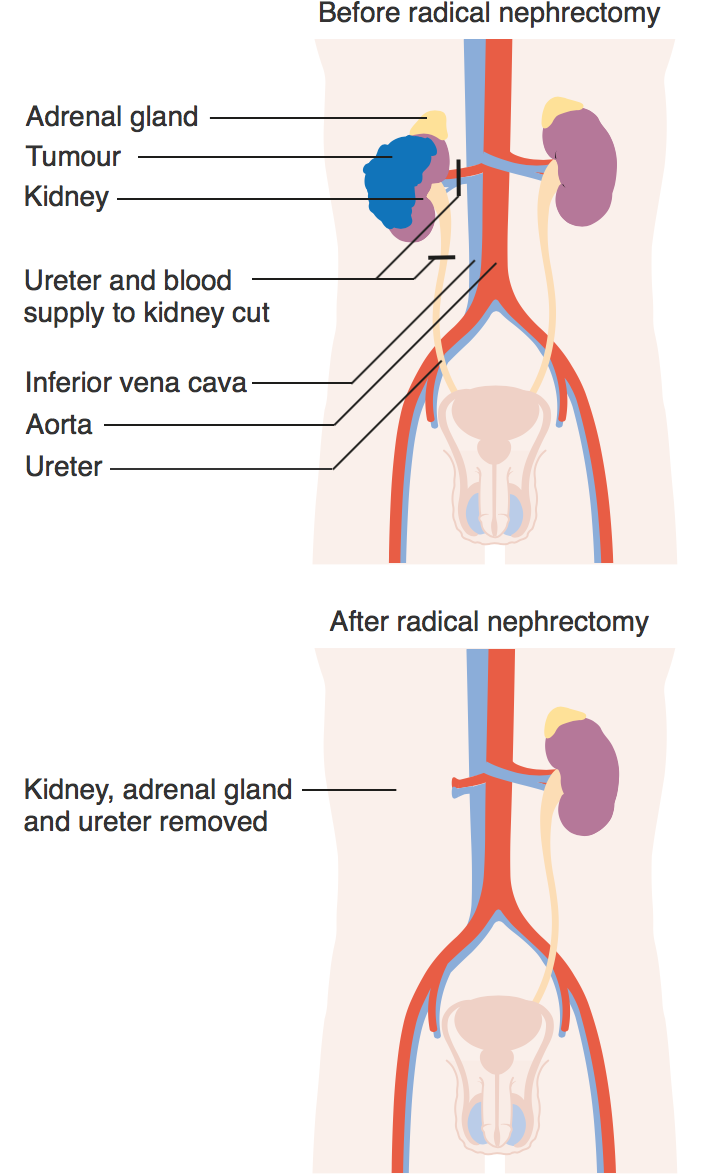Nephrectomy
This means removing the kidney, the lymph nodes, the fatty tissue around the kidney and its tissue covering, with or without the adrenal gland or any nearby involved structures.Under a general anaesthetic, a cut is made under the rib cage (or, depending on the size and site of the tumour, over one side of the lower ribcage, extending around under the arm). The kidney is exposed and its blood supply is cut and tied off.The surrounding tissues are dissected free, without disturbing the kidney covering. The ureter (tube from kidney to the bladder) is cut and tied. The kidney and its fatty covering are dissected, along with its blood vessels and the entire block of tissue is removed and sent for detailed examination. Any bleeding is stopped and the wound is closed.
RISKS
These are the commoner risks. There may be other unusual risks that have not been listed here. Please ask you surgeon if you have any general or specific concerns.There are risks associated with any anaesthetic.You may have side effects from any drugs used. The commoner side effects include light-headedness, nausea, skin rash and constipation.
A radical nephrectomy has the following specific risks and limitations:
- Any of your organs or tissue near the operation site might be damaged.
- Any injuries will be treated at the time of the operation, but may lengthen
- your recovery and have complications of their own. These include:
- Pancreas: Rarely may become inflamed (pancreatitis). This can result in
- metabolic upsets that, in serious cases, can require intensive care and a prolonged recovery.
- Liver (operations on the right): may be torn and bleed. Uncommonly I may need a blood transfusion.
- Small or large bowl: any tears will be repaired, but recovery of normal function may be delayed, and the repairs may heal slowly or leak.
- Spleen (operations on the left): tears may require removal of the spleen, making me more prone to infections and blood clots.
- Stomach: any tears will be repaired, but recovery of normal function may be delayed.
- You may bleed heavily during the operation and require a blood transfusion.
- If the diaphragm is opened to give better access to the kidney, it can be repaired, but you may need a chest tube to allow my lung to re-expand and help with my breathing.
- Your normal bowl function is likely to take some days to recover. You may need several days of fluids given into a vein until recovery begins. This may take 4 – 7 days or occasionally longer.
- Bands of scar tissue rarely form between loops of bowels as the tissue heals. These may cause bowel obstruction in future with bloating and pain. This may settle or may need another operation.
- You may develop an abscess at the operation site, with fever and pain. This may need drainage under X-ray guidance or occasionally, another operation. This is an uncommon problem.
- Your wound may become infected with redness, pain and swelling and occasionally a discharge. This may require antibiotics, or the wound may need to be partly opened.
- Your other kidney may temporarily stop working normally and you may rarely need dialysis until it recovers.
- You may develop a weakness in the wound after it has healed (incisional hernia).
- There is a very small chance you may die due to complications from the operation.
Some of the above risks are more likely if you smoke, are overweight, diabetic, have high blood pressure or have had previous heart disease.
